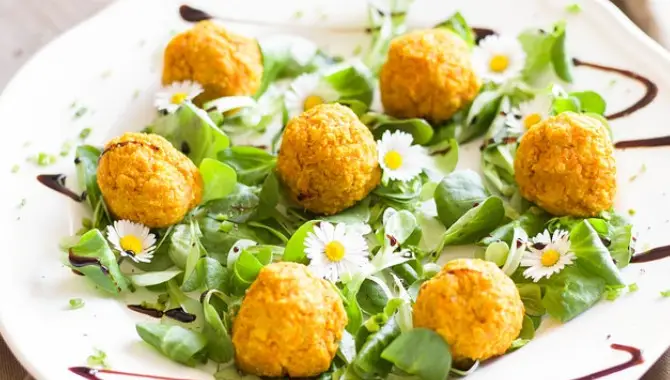Turning vegan can seem a little daunting, especially when it comes to learning which foods are off-limits, but it is important to remember that even experienced vegans run into products they are unsure about. While there are some foods that are clearly vegan in all cases, things become more complicated when a food type can be made in multiple different ways, or when it is difficult to know what the core ingredients are. One example of this is falafel, which many people know to be a popular vegetarian food, but where it is less obvious whether or not any animal products are used.
So is falafel vegan? In most cases, it will contain no meat, dairy or animal products, meaning it is vegan-friendly. With that being said, there are some exceptions to this, especially when dealing with pre-packaged options. Additionally, falafel is often served in flatbread, meaning there are other considerations.
It is very easy to make vegan falafel at home and there is no need to alter any of the core ingredients. Most of the falafel you buy from shops will be fine too, but a certain amount of caution is needed. In this article, I will explain what falafel is, what its main ingredients are and highlight the main pitfalls to avoid. I will also cover some of the ways you can avoid non-vegan falafel and outline some of the potential problems that exist when falafel is served with flatbread.
What is Falafel and Is It Vegan?
Falafel is a popular Middle Eastern dish, which is typically made from either chickpeas, fava beans or a combination of the two. Most commonly, it is served in a ball shape and is cooked via deep frying, although there are variations to this, including flat falafel and baked falafel. Its precise origins are the subject of some debate, but it has grown in popularity in western countries in recent years, especially as a growing number of people seek alternatives to meat-based dishes. However, it is not immediately obvious what the additional ingredients are and whether or not falafel is vegan.
Preparation involves combining ground chickpeas or fava beans with herbs, spices and other ingredients. The most common examples here include cumin, coriander, parsley, scallions and garlic, although other ingredients may also be used to enhance flavour. The mixture is then shaped and cooked in the desired way.
Thankfully, all of these core ingredients are vegan-friendly, including the main optional spices, and this is the traditional way to make falafel. Therefore, in the vast majority of instances, falafel is perfectly safe for vegans to eat. However, there are certain time-saving practices that can lead to issues in terms of avoiding animal products.
Using traditional methods, the chickpeas used in falafel are not cooked prior to being ground together with the spices. Instead, they are soaked for several hours and then ground into the mixture. Yet, one of the main time-saving practices that causes problems here is the use of tinned chickpeas, which have been pre-cooked. When cooked chickpeas are used, the falafel tends to fall apart unless extra ingredients are added for binding purposes. A common binder combination is the use of flour and egg, with the latter being unsuitable for vegans. Meanwhile, when pre-packaged falafel is sold as a dry mix, it sometimes contains dairy, such as milk or butter, and this also needs to be avoided.
There are a few potential ingredients within falafel which are technically vegan, but which are not always accepted by strict vegans, with one example being palm oil. To be clear, palm oil is not an animal product, but the palm oil industry has a poor reputation, often contributing to animal suffering and exploitation. Whether or not you accept the inclusion of palm oil will depend on your rationale on why to become vegan in the first place and I would not wish to influence you in that regard. As with dairy, palm oil is more common with dry mixes than with fresh or pre-prepared falafel.
While falafel can be served and eaten on its own, it is often served in a pita bread, or some other variety of flatbread. I will cover some of the issues around these breads in the next section, but you should also be aware that when buying falafel from certain restaurants, ingredients may be placed inside the bread with the falafel. The main addition you will need to be aware of here is the use of cheese, with feta and cheddar cheese being the most common varieties.
What About Pita or Flatbread?
As previously stated, falafel is often served in a pita bread or another variety of flatbread and this is also something that vegans will need to take into account when trying to ascertain whether or not the dish is vegan-friendly. Fortunately, most pita bread is perfectly in-keeping with a vegan diet, with the main ingredients being flower, water, salt and yeast. Most of the optional additives are vegan too, including citric acid and folic acid, although some store bought pita bread may contain eggs, milk or honey, so check the ingredients list to be sure.
Things become slightly more complicated with other forms of flatbread. While most of these breads will also be suitable for vegans, it is important that you do not simply assume they are vegan-friendly without checking. For instance, Indian-style naan breads will often include ingredients like ghee, butter or milk, while some other flatbread may include eggs in the mixture, or might even be stuffed with meat. Ciabatta bread is also occasionally served with falafel and although this is usually vegan, some varieties of ciabatta use milk instead of water, making it unsuitable.
Moreover, many varieties of bread, including pita, could contain ingredients that occupy a bit of a grey area for vegans. As an example, xanthan gum is sometimes used as a thickening agent. This is usually produced from sugars like glucose, but in a small number of cases, it can be sourced from whey, which is a milk product. Similarly, lecithin is usually derived from soy beans, making it vegan, but it can also be an animal product.
Vegan-friendly sources are far more common, but there is often no way of knowing where these ingredients came from. Some vegans feel it is an acceptable risk, while others may prefer to steer clear unless it is clearly labelled as vegan.
How to Avoid Non-Vegan Falafel
When it comes to avoiding non-vegan falafel, there are a number of things to keep in mind, depending on where you are buying it from and in what form. With pre-made falafel, or dry mixes bought in shops, the most important step is to check the ingredients list for any animal products. In particular, you will want to check that there is no mention of egg, milk or butter and check the allergy information for any reference to dairy. You will also need to make your own mind up about some of the ‘grey area’ ingredients, such as palm oil and xanthan gum, and whether or not these are in-keeping with your decision on why to become vegan in the first place.
When possible it is best to try to stick to brands that have specifically labelled their product as vegan, or where the product has been certified as vegan-friendly by a credible organisation. If you are in any doubt about whether or not a falafel product is vegan, you might want to consider calling the brand’s customer support line, emailing the brand, or reaching out to the customer service team via one of the main social media platforms.
If you are buying from a restaurant, check the menu and ask if you have any doubt about whether the falafel is vegan. I would recommend letting restaurants know you are vegan anyway, as this will allow the kitchen staff to make adjustments in order to avoid accidental cross-contamination. If you are buying falafel within bread, you will need to make sure the bread is vegan too, and while this is usually not a problem with pita bread, it can be with naan and other flatbread types. Of course, the single best way to guarantee your falafel is vegan is to make it at home.
Making Vegan Falafel At Home
Many vegans prefer to make their falafel at home, whether it is to guarantee that all of the ingredients are vegan and high-quality, or simply for the sense of achievement and satisfaction. Although the preparation is relatively simple, it does take time and you will need to start preparing the day before you want to actually eat the falafel.
To make homemade falafel, you will need dried, uncooked chickpeas and any herbs or spices you intend to add to the mix. You will also need a food processor, or some other means of grinding the ingredients together. The chickpeas will need to be left to soak in plenty of water for several hours. At minimum, you will likely need to do this overnight and ideally, you should soak them for as long as 15 to 18 hours. Once the chickpeas are ready, add them to the food processor, along with your additional ingredients. Common examples are cumin, coriander, parsley and garlic.
Turn the processor on and allow it to blitz the ingredients until everything has combined together, forming a thick paste. Take the mix and transfer it to a bowl, and then place the bowl in the fridge for around an hour. Once it has cooled sufficiently, use the mix to create your round falafel patties. The ingredients should stick together well. If you have used cooked chickpeas or the falafel is falling apart, you could add a small amount of flour to help.
From there, all you need to do is cook the falafel balls in your preferred way. The traditional method is to deep fry them, and this will only take around three minutes, until the outside of the patties turns brown. You can bake them instead, although this produces less reliable results. At 350°F, you will need to cook them for around 20 minutes.
Welcome to VeganClue - My name is Robert Van De Ville and together with my team we spent hundreds of hours researching the most relevant topics for Vegans and non yet Vegans. Are you looking for more information about Veganism, animal welfare, diet, health, and environmental benefits of the Vegan lifestyle? You are in the right place! Enjoy the site.

